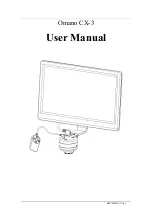
Appendix B: GPIB System Concepts
2714 & 2715 Programmer Manual
B–15
to go to a remote mode with front-panel lockout. The UNL (Unlisten) command
does not return an instrument to the local mode.
When the REN line goes false it must be recognized by all instruments on the
bus, and they must go to the local mode within 100
m
s. If data bytes are still
being placed on the bus when REN goes false, the system program should ensure
that the data bytes are sent and received with the knowledge that the system is in
a local mode as opposed to remote mode.
The T/TE and L/LE functions are independent of each other, although they are
discussed under one heading.
The T (Talker) and TE (Talker Extended) functions provide an instrument and its
secondary devices, if any, with the capability to send device-dependent data over
the GPIB (or, in case of a controller, the capability to send device-dependent
program data) over the GPIB. The Talker (T) function is a normal function for a
talker and uses only a one-byte primary address code called MTA (My Talk
Address). The Talker Extended (TE) function requires a two-byte address code,
an MTA code followed by the second byte called MSA (My Secondary Address).
Only one instrument in the GPIB system can be in the active talker state at one
time. A non-controller begins talking when ATN is released and continues its
talker status until an Interface Clear (IFC) message occurs or an Untalk (UNT)
command is received from the controller in charge. The instrument will stop
talking and listen any time the controller in charge asserts ATN.
One or more instruments on the bus can be programmed for the L (Listener)
function by using their specific primary listen address (called MLA). Some of
the instruments interfaced to the bus may be programmed for the LE (Listener
Extended) function, if implemented. The LE function requires a two-byte address
code. No L or LE function is active during the time that ATN is asserted.
An instrument may be a talker only, a listener only, or implement all functions.
All talker and listener functions must respond to ATN within 200 ns. They must
also respond to IFC in less than 100
m
s. In any case, its address code has the
form X10TTTTT for a talker and X01LLLLL for a listener. For instruments with
both T and L functions, the T-bit binary values are usually equal to the binary
value of the L bits. Before applying power to the system, the system operator
sets these five least significant bits by means of an address switch on each
instrument. The controller’s address code may be implemented in software.
The system program, run from the controller, designates the primary talker and
primary listener status of the desired instruments by coding data bits 6 and 7.
These bits are set to 1 and 0, respectively, for a talker and 0 and 1, respectively,
for a listener. Secondary talk and listen addresses (or commands) are represented
by the controller sending both data bits (6 and 7) as a logical 1. The controller
may listen to bus traffic without actually addressing itself over the bus.
T/TE and L/LE (Talker and
Listener Functions)
Summary of Contents for 2714
Page 4: ......
Page 11: ...Introduction ...
Page 12: ......
Page 38: ...Introduction to Programming 1 26 2714 2715 Programmer Manual ...
Page 39: ...Message Structure ...
Page 40: ......
Page 54: ...Instrument Specific Message Structure 2 14 2714 2715 Programmer Manual ...
Page 55: ...Functional Groups ...
Page 56: ......
Page 85: ...Command Query ...
Page 86: ......
Page 179: ...Status Reporting ...
Page 180: ......
Page 197: ...Programming ...
Page 198: ......
Page 266: ...Programming 6 68 2714 2715 Programmer Manual ...
Page 267: ...Appendices ...
Page 268: ......
Page 276: ...Appendix A RS 232 Concepts A 8 2714 2715 Programmer Manual ...
Page 296: ...Appendix B GPIB System Concepts B 20 2714 2715 Programmer Manual ...
Page 297: ...Index ...
Page 298: ......
Page 307: ......
Page 308: ......
















































